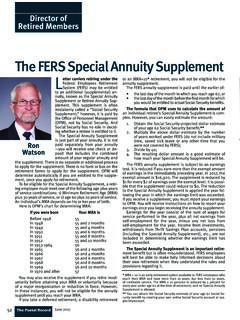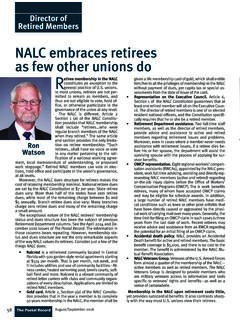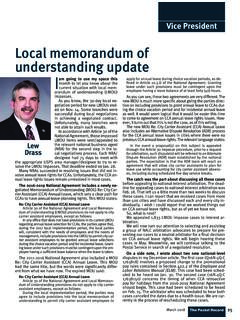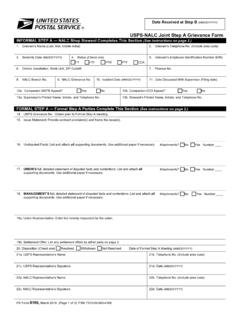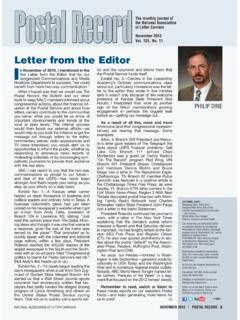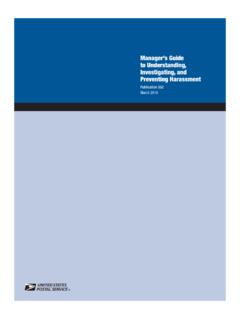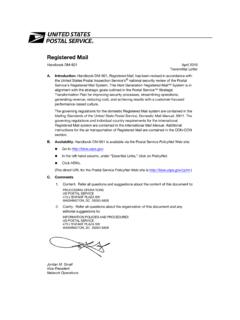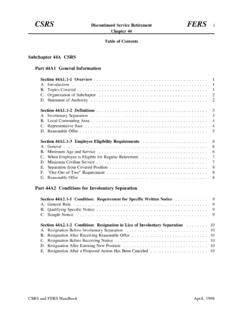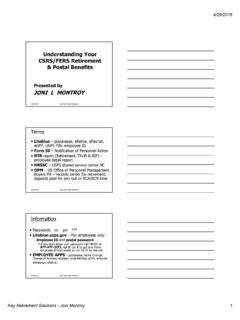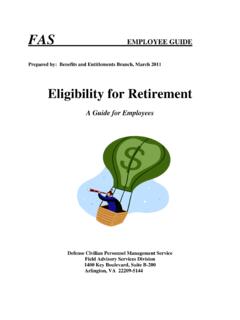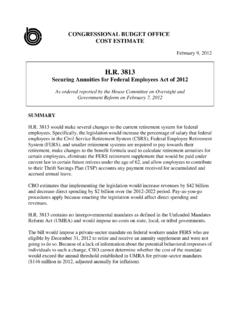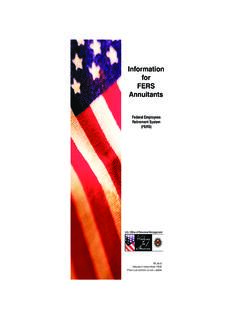Transcription of FERS annuity supplement T
1 The Postal Record 39 The fers retiree annuity sup-plement is probably the least-understood component of the fers retirement system. Commonly referred to as the fers Social Se-curity supplement , its general pur-pose is to provide a level of income before age 62 similar to what the retiree will receive at age 62 as part of a Social Security benefi supplement is paid by the Offi ce of Personnel Management (OPM), not Social Security. Howev-er, the formula used to compute the supplement is quite different from the formulas used to compute other benefi ts paid by OPM because it is an adaptation of the Social Security benefi ts of the general points regarding the supplement are listed below: It is unique to fers there is no comparable provi-sion under CSRS.
2 It is not payable to individuals who take disability retirement, or retire under the MRA + 10 provision*, or retire at age 62 or later. It is immediately payable to individuals who retire at or after MRA with at least 30 years or service, or at age 60 with at least 20 years of service. It is payable to individuals who retire under a volun-tary early retirement (VER) but not necessarily imme-diately instead, it does not begin until the retiree reaches MRA. It is only paid until the age of 62, at which time it terminates. It is subject to an earnings offset for wages earned that exceed an amount set by Social Security (the amount increases annually). It requires retirees to report annual earnings to OPM. It is not increased by cost-of-living adjustments (COLAs).
3 Computation of the fers annuity supplement is highly complex. In general, a Social Security Primary Insurance Amount (PIA) is computed as if the retiree were age 62 and fully insured by Social Security with an actuarial age reduction factor. The reduced PIA is then multiplied by the number of years of civilian service creditable under fers and divided by 40. For example, if a 59-year-old retiree had 32 years of fers service, her annuity supplement would be calculated as follows: PIA times 32 divided by individual who obtains employment after retiring may lose all or part of the annuity supplement for the following year if the amount earned in a year exceeds the Social Se-curity exempt amount. Note, however, that the reduction applies only to the annuity supplement .
4 There is no earn-ings deduction for the fers basic , for the purpose of annuity supplement reduc-tion, consist of wages and net earnings from self-employ-ment. The annuity supplement is not reduced by income from investments or similar sources. The amount of the reduction is $1 for every $2 that is earned above the Social Security exempt amount. Social Security sets the exempt amount each year. In 2013, the amount is $15, in the annuity supplement are applied in the year following receipt of earnings that exceed the exempt amount. For example, a 59-year-old retiree receives an annuity supplement of $9,000 a year. In 2013, he works part time and has earnings of $20,120. As noted above, the exempt amount in 2013 is $15,120.
5 He earned $5,000 above the exempt amount. The reduction is $1 for every $2 earned above the exempt amount. Therefore, the reduction is $2,500. The reduction is applied the year following the excess earnings. In 2014, this retiree would receive $9,000 minus $2,500 for a reduced total of $6, the same retiree had earned wages of $40,000 in 2013 (instead of $20,120 in the example above), he would re-ceive zero supplemental annuity in 2014. $40,000 exceeds the 2013 exempt amount of $15,120 by $24,880. The 2014 annuity supplement would be reduced by $1 for every $2 earned above the exempt amount; therefore, it would be reduced by $12,440. Since the reduction is more than $9,000, zero annuity supplement would be paid in continue the above examples, if the retiree sub-sequently had zero earned wages in 2014, then the full $9,000 annuity supplement would be paid in 2015.
6 This is so even though the 2014 annuity supplement was reduced (by $2,500 in the fi rst example, or by the full $9,000 in the second example) due to excess earnings. Reductions in the annuity supplement are driven solely by excess earnings in the previous fers annuity supplement is a valuable but little-understood benefi t. Source documentation is found at 5 USC 8421, 5 CFR , and Offi ce of Personnel Manage-ment (OPM) fers Handbook Chapter 51. * MRA is minimum retirement age. It varies between 55 and 57, depending on year of birth. MRA + 10 is an early retirement that is reduced 5 percent for every year under age 62. fers annuity supplementDirector ofRetired MembersOctober 2013 RonWatso
